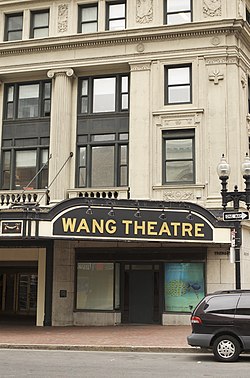Wang Theatre
 |
|
| Former names | Metropolitan Theatre (1925-1962) Music Hall (1962-1980) |
|---|---|
| Address | 270 Tremont St. |
| Location | Boston, Massachusetts |
| Public transit |
Tufts Medical Center (Orange Line) |
|
Metropolitan Theatre
|
|
| Coordinates | 42°21′1″N 71°3′53″W / 42.35028°N 71.06472°WCoordinates: 42°21′1″N 71°3′53″W / 42.35028°N 71.06472°W |
| Built | 1923 |
| Architect | Blackall,Clapp & Whittemore; Multiple |
| Architectural style | Renaissance |
| MPS | Boston Theatre MRA |
| NRHP Reference # | |
| Added to NRHP | December 9, 1980 |
| Owner | Boch Center |
| Operator | Boch Center |
| Type | Theatre |
| Capacity | 3,500 |
| Opened | 1925 |
| Website | |
| www |
|
Tufts Medical Center (Orange Line)
Boylston (Green Line)
The Wang Theatre (est. 1983) of Boston is located in a historic 1925 building that was originally the Metropolitan Theatre, and later the Music Hall. It was designed by Clarence Blackall and is located at 252-272 Tremont Street in the Theatre District. The business is operated as part of the Boch Center (formerly the Citi Performing Arts Center). The building was also known as the Metropolitan Center. The theatre was designated as a Boston Landmark by the Boston Landmarks Commission in 1990.
The structure was originally known as the Metropolitan Theatre when it opened in 1925. The Metropolitan Theatre was developed by Max Shoolman and designed by architect Clarence Blackall, with the assistance of Detroit theatre architect C. Howard Crane. It seats more than 3,600 people.
In 1962 it became the home of the Boston Ballet and was renamed the Music Hall. During the 1960s and 1970s, audiences could see the Stuttgart Opera, the Metropolitan Opera, Bolshoi Ballet and Kirov Ballet as well as popular movies and performing artists. With time though, they could no longer attract the large touring companies because of the size of their stage as well as their outdated production facilities. Converted to a non-profit center in 1980 and renamed the Metropolitan Center, they were able to attract theatrical performances again.
In 1983, Dr. An Wang made a very large donation and the Wang Center was born. From 1989 - 1992, $9.8 million was raised to restore the Theatre to "its glory days of the 1920s". Boston based architecture firm Finegold Alexander + Associates Inc restored the theatre with Conrad Schmitt Studios performing the elegant decoration, gilded moldings, murals, scagliola and marbleized surfaces.
...
Wikipedia



